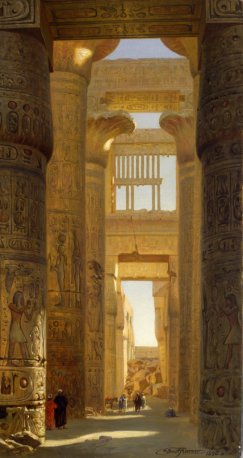The Temple of Karnak, The Great Hypostyle Hall
Egyptosophy
The Temple of Karnak, The Great Hypostyle Hall [ edit ]
Koemer has captured the Temple of Karnak in all of its majesty, here painting the massive columns of the hypostyle hall. The colossal columns, constructed around 1250 BCE, are a representation of a primordial marsh, and functioned as a shrine for the sacred boat of the god Amun as it passed in and out of Karnak Temple. Early medieval alchemists in Egypt referred to alchemy as the "science of the temples." Two early Arabic alchemical treatises claim to have been found within Egyptian ruins, and the tenth century CE alchemist Ibn Usmail compared the alchemical laboratory's oven to an ancient Egyptian temple (here translated by H.E. Stapleton and M Hidayat Husain):
"In Egypt are structures called birābī (temples) made of enormous--not to say gigantic--stones. A birbā‘ (temple) contains rooms of different shapes in which are places for Admixture, Pounding, Solution, Coagulation, and Distillation, which indicates that each of them was built for the Art of Alchemy. In these temples are drawings and inscriptions in the Chaldean and Koptic languages, but it is not known what they are."
The medieval Islamic alchemist, like the later Jesuit Athanasius Kircher, was able to interpret earlier pagan structures through a lens of "science" acceptable to the monotheistic religion of the day. Graeco-Roman temples such as that of Edfu indeed contain rooms around the rear central chamber dedicated to gold working and the preparation of scented potions--practices that are the basis for alchemy.
Date
1890
Dimensions
31 1/4 x 18 1/4 in
Artist or Author
Ernst Karl Eugen Koerner
Provenance
Germany
Material
viterbo
Museum
Dahesh Museum
Accession Number
1995.114








